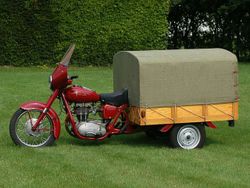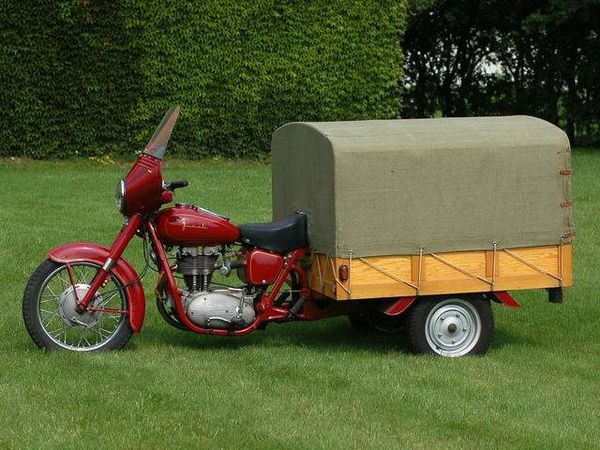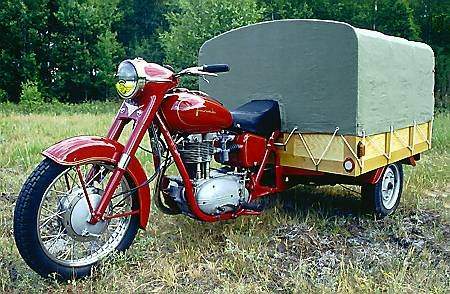Junak B20
 |
|
| Junak B20 | |
| Manufacturer | |
|---|---|
| Production | 1960 |
| Class | Trike |
| Engine | Four stroke, single cylinder, OHV |
| Bore / Stroke | 76.2mm x 76.2mm |
| Compression ratio | 7.0:1 |
| Horsepower | 19.04 HP (14.2 KW) @ 6000RPM |
| Torque | 19.92 ft/lbs (27.0 Nm) @ 3800RPM |
| Fuel System | Carburetor |
| Transmission | Gear box: 4-Speed Final Drive: Chain |
| Suspension | Front: Fork with coil springs telescopic shock absorbers Rear: Independent rear wheel suspension on single wishbone , cooperating with 7- leaf spring positioned transversely |
| Brakes | Front: Full hub width, of expander shoe type, hand operated Rear: Full hub width, of expander shoe type, foot operated |
| Wheelbase | 79.09 inches (2009 mm) |
| Length | 120.31 inches (3056 mm) |
| Width | 55.91 inches (1420 mm) |
| Seat Height | 29.69 inches (754 mm) |
| Weight | 320.0 kg (wet) |
| Manuals | Service Manual |
The Junak B20 was a Four stroke, single cylinder, OHV Trike motorcycle produced by Junak in 1960. Max torque was 19.92 ft/lbs (27.0 Nm) @ 3800 RPM. Claimed horsepower was 19.04 HP (14.2 KW) @ 6000 RPM.
Engine[edit | edit source]
A 76.2mm bore x 76.2mm stroke result in a displacement of just 349.0 cubic centimeters.
Drive[edit | edit source]
The bike has a 4-Speed transmission. Power was moderated via the Wet Multi-plate.
Chassis[edit | edit source]
Stopping was achieved via Full hub width, of expander shoe type, hand operated in the front and a Full hub width, of expander shoe type, foot operated in the rear. The front suspension was a Fork with coil springs telescopic shock absorbers while the rear was equipped with a Independent rear wheel suspension on single wishbone , cooperating with 7- leaf spring positioned transversely. The wheelbase was 79.09 inches (2009 mm) long.
1960 - 1965 Junak B20[edit | edit source]
Junak B20, a three-wheel transport version of Polish Junak motorcycle, based on serial M10 model. From 1960 to 1965 about 2500 units were built, 153 of them were exported. Very few B20 are preserved.
The B20 proved to be superior to B21, with greater top speed (75 km/h when compared with 60 km/h) and possibility to carry 300 kg of load, when the own weight of the three-wheel vehicle was 320 kg. Fuel usage was about 5,7 l/100 km.

